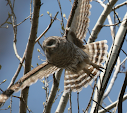
A trip of birding photographers is the best, everyone understands that shooting through the car and past a passenger's head is perfectly acceptable when the bird is on the other side of the road. The favor was returned back and forth multiple times. My next life bird, also seen before we had reached the NWR proper, was a McCown's Longspur, this time posing on my side of the vehicle.

Our first stop inside the refuge was behind the brush where we had all staked out the Marsh Wrens. As we enjoyed our sheltered spot we were also treated to occasional flyovers, such as this Forster's Tern.

We weren't the only ones seeking shelter. As we drove between two lakes we had a nice look at a Willet, which had abandoned the water for the relative calm of some scrub brush.

We also saw it's evil twin, the less well known 'horned willet'. Right, same bird, but the wind did lend itself to lame jokes.

The birds were all doing their best to cope with the strong winds, but some species are just designed to thrive in such conditions. The Northern Harrier, a species that normally glides effortlessly over fields and marshlands anyway, was able to fully extend and use every gust to scrutinize the flooded cattail beds.

We humans, on the other hand, were not so well adapted. We gathered our tied down hats and wind battered senses, and headed south for the border and calmer air to enjoy our lunch. One more impromptu stop awaited, and one more life bird for myself, but that will show up in a final post.
Photography, like birding, is one of those hobbies that lends itself to the quiet contemplation of nature. I find that through scheduling and the opportunistic style of most of my birding that I am generally alone when I pursue both activities. So, it is refreshing to get out with a bunch of folks who enjoy combining the two as much as I do. As great as group birding is, it can often be detrimental to those of us who are always looking for the next good shot. Birding courtesy dictates that a photographer allow the group to get good bins on the bird before pointing a long lens at the target and firing away. It was rewarding to be with others who were also seeking the shot as a goal. If you know other bird photographers in your area you may want to set up a designated bird/photo trip of your own. I am not going to say that this one took me from being an average photographer to an expert, but I definitely came away with some new insights and techniques to try.


No comments:
Post a Comment